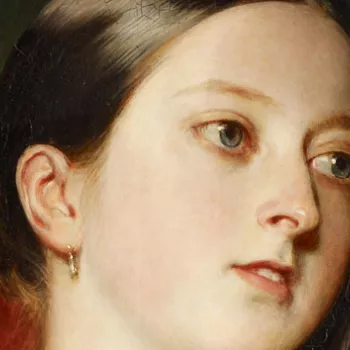The Adoration of the Kings c. 1530
Oil on oak panel | 48.1 x 38.7 cm (support, canvas/panel/stretcher external) | RCIN 405784
-
In his biography of Dutch and Flemish Painters of 1604 Karel Van Mander commented: ‘The city of Aelst need not be modest and silent; she does not have to bow to other cities who boast that they have produced world renowned artists. Aelst produced Pieter Koeck.’ Van Aelst is thought to have trained with Bernard van Orley (c. 1492 – 1542) and spent the majority of his career in Antwerp, joining the Guild there in 1527. He led a large workshop producing paintings, architectural designs, books, sculptures, tapestries and stained glass. He was recorded in Constantinople in 1535 and possibly also visited Rome. In the year of his death he was appointed court artist to the Holy Roman Emperor Charles V in Brussels.
Rather than taking place in a stable, van Aelst’s Adoration of the Kings is set amidst the ruins of a highly decorative classical building, symbolizing the transition, following the birth of Christ, from the crumbling Old Law of the Old Testament to that of the New. The composition has an overall sense of movement which heightens the unfolding drama. One of the kings kneels expansively before the Christ Child who is held out by the Virgin, and a second king offers his gift whilst the third, accompanied by a soldier, enters through the dilapidated triumphal arch-way. The twisting poses, particularly in the figure of St Joseph with his right shoulder raised and left hand resting heavily on a stick, the contrast of Joseph’s head turned towards the scene with that of a donkey twisting away and upwards, and the contrapposto of the soldier and a figure in an exotic hat on the far right, indicate van Aelst’s knowledge of Italian Mannerist painting, most notably the works of Raphael. The artist also seems to have been influenced by Dürer’s 1511 woodcut of the same scene from the German master’s Life of the Virgin series.
Van Aelst’s interpretation neatly combines elegance with brutality, leading the viewer to sense impending doom. The inclusion of a group of armed soldiers approaching along the winding path in the distance, the rocky terrain and the swirling banner held aloft by the soldier on the right may anticipate the violence of the biblical episodes of the Flight into Egypt and Massacre of the Innocents. The outstretched arms and dangling legs of the Christ Child, whilst lending him extra presence and child-like enthusiasm, also prefigure his Crucifixion. The subject was popular, and many versions survive by followers of the Antwerp-based artist.
Text from Northern Renaissance: Durer to Holbein, London 2011Provenance
One of the group of early Flemish works from the 77 paintings belonging to Prince Ludwig von Oettingen-Wallerstein (1791-1870), which were first offered to Prince Albert in 1847 as security for a loan and came into his possession by default (no 51 in Waagen’s catalogue of 1854); 25 of them were accepted by the National Gallery in 1863
-
Creator(s)
Acquirer(s)
-
Medium and techniques
Oil on oak panel
Measurements
48.1 x 38.7 cm (support, canvas/panel/stretcher external)
70.1 x 59.9 x 5.2 cm (frame, external)










